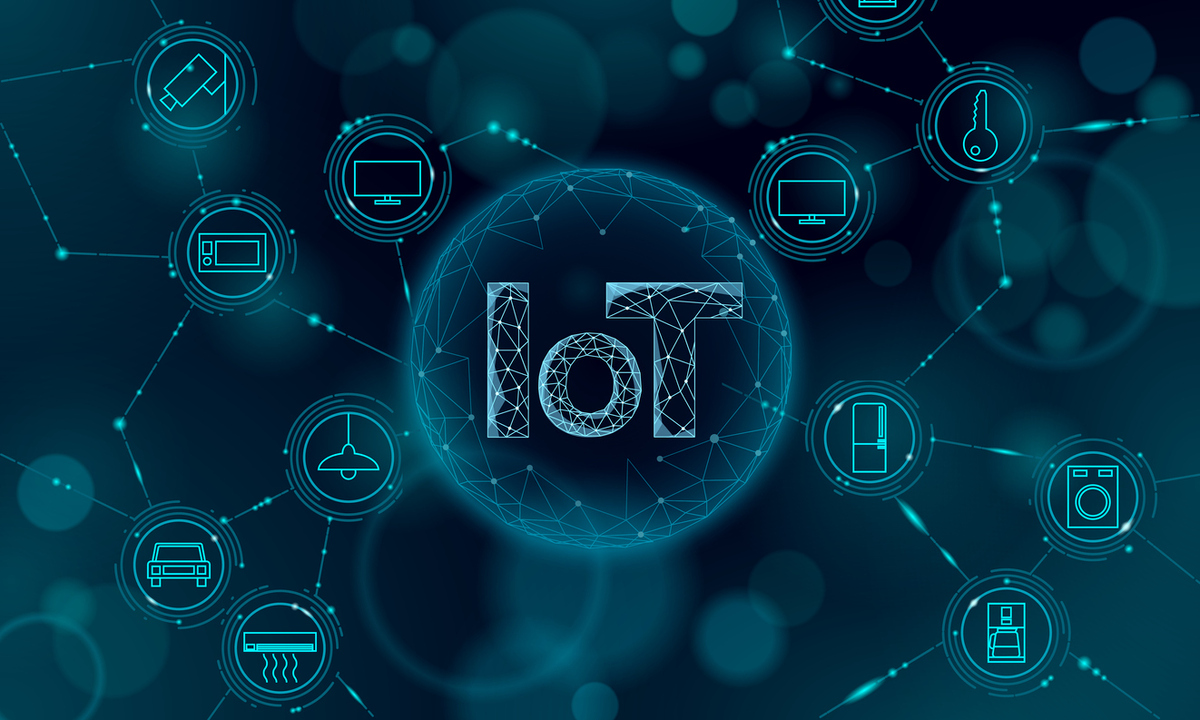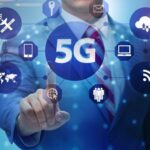The Internet of Things (IoT) is a concept that has begun to shape our world in unprecedented ways. It refers to the network of physical objects embedded with sensors, software, and other technologies, connected to collect and exchange data.
Definition of IoT
The Internet of Things (IoT) signifies a paradigm where everyday objects are equipped with the capacity to transmit and receive data over the internet or other forms of networks. This is achieved through embedding these objects with sensors, software, and other technologies. The primary objective of IoT is to eradicate the gap between the physical and digital worlds, thereby enabling a level of communication and interaction that was previously deemed unattainable.
At its core, IoT encompasses the idea of extending internet connectivity beyond traditional devices like desktop and laptop computers, smartphones and tablets to a range of traditionally dumb or non-internet-enabled physical devices and everyday objects. This includes everything from household appliances like refrigerators and thermostats, to industrial machines, medical devices, vehicles, and even buildings. These connected devices can collect and analyze data to create actionable insights, which can be used to improve efficiency, enable new services, or enhance human life in various ways.
The foundation of IoT lies in the ubiquity of internet access, the availability of IP addresses (thanks to IPv6), and the reduction in cost of sensors and processors which make it feasible to turn physical objects into smart devices. Each of these “things” in IoT has a unique identifier and the capability to transfer data over a network without requiring human interaction.
Here are some integral components of IoT:
- Sensors: These are the eyes and ears of IoT, collecting data from the environment or the object they are attached to. Sensors can range from simple temperature sensors to complex full video cameras or sensors collecting specific health data.
- Connectivity: For an IoT system to work, its components need to be connected to a network to send and receive data. This can be done through a variety of ways including Wi-Fi, Bluetooth, Zigbee, or cellular connections.
- Data Processing: Once data is collected, it needs to be processed to make sense of it. This can happen on the devices themselves (edge computing), nearby (fog computing), or on a centralized server or cloud service.
- Action: The processed data leads to actionable insights, which can then be used to initiate a specific action. For instance, if a soil moisture sensor in an agricultural IoT setup detects dry conditions, it can trigger the irrigation system.
- User Interface: There needs to be a way for users to interact with the IoT system, whether it’s a dashboard for monitoring data, or an alert sent to a smartphone, or automated actions triggered within a system.
IoT has vast potential and is seen as a key driver of the Fourth Industrial Revolution. The technology has the power to significantly impact various sectors of society including healthcare, agriculture, transportation, and smart cities among others. Through IoT, a new level of efficiency and automation can be achieved, which in turn, holds the promise of resolving complex issues, improving quality of life, and opening up new opportunities for economic growth.
Transforming Everyday Life
The Internet of Things (IoT) is significantly transforming everyday life, making our routines more convenient, efficient, and enjoyable. This transformation is pervasive, touching almost every aspect of our daily experiences from the moment we wake up to the time we go to bed. Here are some domains where IoT is making a notable impact:
Smart Homes
IoT has facilitated the emergence of smart homes, where appliances and systems can be controlled remotely and interact with each other to automate routine tasks. For instance, smart thermostats can learn your preferences and adjust the temperature to save energy when you’re not at home. Smart locks enhance security by allowing remote monitoring and control. Moreover, smart lighting systems can be programmed to mimic your routine, which can deter burglars when you’re away.
Health and Fitness
IoT devices like fitness trackers and smartwatches have become personal health companions, monitoring various health metrics such as heart rate, sleep quality, and physical activity. They provide insightful data that can encourage a healthier lifestyle or even alert you to potential health issues. Moreover, smart medical devices enable remote monitoring of patients, timely medication reminders, and provide critical data to healthcare providers for better diagnosis and treatment.
Transportation and Mobility
IoT is revolutionizing transportation through smart vehicles and intelligent transportation systems. For instance, real-time traffic monitoring and smart navigation systems help in reducing travel time and fuel consumption. IoT-enabled vehicles can communicate with each other and traffic infrastructure to prevent accidents. Moreover, smart parking solutions help in finding available parking spots, thus reducing the stress of parking in crowded urban areas.
Education
IoT in education facilitates a more interactive and personalized learning experience. Smart classrooms allow real-time collaboration, access to rich educational resources, and enhanced monitoring of student performance. Additionally, IoT helps in ensuring the safety of school premises through smart surveillance systems and emergency notification systems.
Entertainment
The entertainment sector has also embraced IoT. Smart TVs, speakers, and gaming systems provide a personalized entertainment experience by learning user preferences. Moreover, IoT allows seamless integration and interaction among different devices, enhancing the overall entertainment experience.
Shopping and Retail
IoT is transforming the retail experience through smart shopping solutions. For instance, smart carts can help in navigating through the store, checking out without waiting in line, and even keeping track of spending. Moreover, IoT enables retailers to manage inventory efficiently and provide personalized shopping experiences through data analysis.
The integration of IoT in daily life is a testimony to how the fusion of physical and digital worlds can significantly enhance the quality of life. It’s not just about the convenience and efficiency; it’s about creating a more responsive environment that can adapt to individual needs and preferences. The journey of IoT is just at its nascent stage, with a promise of unfolding more transformative experiences as technology advances. Through its ability to make everyday objects intelligent and responsive, IoT is indeed weaving a new narrative in the tapestry of everyday life, making the mundane magical.
Impact on Industries
The Internet of Things (IoT) is not only transforming everyday lives but is also significantly impacting various industries. It’s driving efficiency, enabling new business models, and revolutionizing the way businesses operate. Here’s a look at some of the industries where IoT is making a substantial impact:
Manufacturing
IoT is at the forefront of the Industrial Revolution 4.0, reshaping manufacturing. Smart factories equipped with IoT devices can monitor and optimize production in real time. Sensors on machinery can predict maintenance needs, reducing downtime and preventing costly breakdowns. Moreover, IoT facilitates better supply chain management through real-time monitoring and analytics, ensuring timely delivery and reducing inventory costs.
Agriculture
In agriculture, IoT is promoting precision farming. Farmers can monitor soil moisture, crop growth, and livestock conditions remotely. Automated irrigation systems, for instance, can optimize water usage. Drones and sensors can provide real-time data on crop health, helping to detect diseases early. Through IoT, farmers can make data-driven decisions, improving yields and reducing resource usage.
Healthcare
IoT is transforming healthcare through smart medical devices and telehealth services. Remote patient monitoring, medication adherence systems, and smart prosthetics are some of the IoT applications improving patient care. Moreover, IoT data can inform better decision-making for healthcare providers and enable timely interventions, which is crucial for chronic disease management and elderly care.
Retail
The retail sector is leveraging IoT to enhance customer experience and operational efficiency. Smart shelves, for example, can monitor inventory levels in real-time, preventing stock-outs. IoT also enables personalized marketing by analyzing customer behavior and preferences. Moreover, smart payment systems expedite the checkout process, enhancing customer satisfaction.
Transportation and Logistics
IoT is vital in optimizing logistics and fleet management. Real-time tracking of vehicles, goods, and assets improves route planning and ensures timely delivery. Predictive maintenance of vehicles reduces downtime, while IoT-enabled smart containers ensure the safety and quality of transported goods.
Energy
In the energy sector, IoT aids in monitoring and managing energy production and distribution. Smart grids enable better control over energy supply, reducing wastages. Moreover, IoT can optimize the operation of renewable energy systems, making energy consumption more efficient and sustainable.
Smart Cities
IoT is foundational in developing smart cities. It aids in traffic management, waste disposal, and emergency response systems, creating a safer and more efficient urban environment. Through a network of connected devices, cities can become more responsive to the needs of their inhabitants.
Hospitality
In the hospitality industry, IoT enhances guest experience through smart room systems, personalized services, and efficient operations. For instance, smart thermostats and lighting can adjust according to guest preferences, ensuring a comfortable stay.
The integration of IoT across industries is a testament to its transformative power. It’s not only about streamlining operations but also about unlocking new potentials and driving innovation. As IoT continues to mature, its impact on industries is bound to expand, heralding a new era of smart, connected, and efficient operations that would fuel economic growth and societal advancement.
Emerging Technologies in IoT
The Internet of Things (IoT) is a dynamic field, constantly evolving with emerging technologies that push the boundaries of what’s possible. As IoT matures, new innovations continue to emerge, enhancing its capabilities and applications. Here are some of the emerging technologies that are shaping the future of IoT:
5G Connectivity
5G, the fifth-generation wireless technology, is poised to revolutionize IoT. With significantly faster data transfer speeds, lower latency, and support for massive device connectivity, 5G unlocks new possibilities. It enables real-time applications like autonomous vehicles, remote surgery, and augmented reality. 5G’s robust network connectivity will be crucial for the growth of IoT in various domains.
Edge Computing
Edge computing is a game-changer for IoT applications that require low latency and rapid data processing. Instead of sending all data to centralized cloud servers, edge devices process data locally. This reduces latency, conserves bandwidth, and allows IoT systems to respond quickly to real-time events. Edge computing is particularly valuable in sectors like autonomous vehicles and industrial automation.
Artificial Intelligence (AI) and Machine Learning (ML)
AI and ML are augmenting IoT by enabling devices to analyze data, make decisions, and learn from their experiences. For example, smart cameras can detect anomalies and identify objects in real-time. Predictive maintenance systems use ML to analyze sensor data and forecast equipment failures, reducing downtime. AI-driven chatbots provide better customer support in IoT applications.
Blockchain
Blockchain technology is enhancing the security and trustworthiness of IoT systems. It provides a tamper-resistant ledger for recording device transactions and data exchanges. This ensures data integrity and prevents unauthorized access. In supply chain management and healthcare, blockchain ensures the provenance and security of IoT data.
Quantum Computing
While quantum computing is still in its infancy, it holds immense potential for solving complex IoT-related problems. Quantum computers can handle vast amounts of data and execute calculations at speeds unimaginable with classical computers. In IoT, this could lead to breakthroughs in cryptography, optimization, and simulation.
Augmented Reality (AR) and Virtual Reality (VR)
AR and VR are merging with IoT to create immersive experiences. IoT devices can provide real-world data to enhance AR experiences. For instance, AR glasses for technicians can overlay repair instructions on equipment. VR can be used for remote monitoring and training in IoT applications like telemedicine and industrial maintenance.
Biotechnology and Bioinformatics
IoT is expanding into healthcare and biotechnology with wearable devices that monitor health metrics. Advanced sensors and genetic analysis tools are being integrated into IoT platforms for personalized medicine and disease prevention. Bioinformatics algorithms help analyze and interpret biological data collected by IoT devices.
Robotics and Automation
IoT-driven robots and autonomous systems are becoming more sophisticated. They can navigate complex environments, interact with humans, and perform tasks efficiently. In industries like logistics and manufacturing, IoT-enabled robots are improving efficiency and productivity.
Energy Harvesting
Energy-efficient IoT devices are crucial for sustainability. Energy harvesting technologies allow IoT sensors and devices to generate power from their surroundings, such as solar energy, vibration, or heat. This reduces the need for battery replacements and extends the lifespan of IoT deployments.
Biometric Authentication
Biometric authentication is enhancing the security of IoT applications. IoT devices can use biometric data like fingerprints, facial recognition, or voice recognition for user identification and access control. This is especially important in securing IoT-enabled smart homes and workplaces.
The synergy between IoT and emerging technologies is propelling the development of innovative solutions across various sectors. As these technologies continue to evolve, we can expect IoT to become even more integral to our daily lives, driving efficiency, sustainability, and improved user experiences. The future of IoT is undoubtedly exciting, promising a world where connectivity and intelligence converge to shape a smarter, more responsive world.
Security and Privacy Concerns in IoT
While the Internet of Things (IoT) offers immense potential, it also brings forth significant security and privacy concerns that must be addressed to ensure the safe and responsible adoption of this technology.
Data Privacy
Data Collection and Usage: One of the foremost concerns in IoT is the collection and usage of personal data. IoT devices often gather a vast amount of data, including sensitive information about individuals. This data can be misused or exploited if not handled with care.
Consent and Transparency: Users may not always be aware of what data is being collected and how it is being used. Clear consent mechanisms and transparent data policies are essential to protect user privacy.
Data Security
Vulnerabilities: IoT devices can be vulnerable to cyberattacks. Many devices have limited computational capabilities, making them easy targets for hackers. Unpatched vulnerabilities can be exploited to gain unauthorized access.
Data Encryption: Data transmitted between IoT devices and cloud servers should be encrypted to prevent interception and tampering. Weak or non-existent encryption can lead to data breaches.
Device Security
Default Passwords: Some IoT devices come with default usernames and passwords that are rarely changed by users. These can be easily exploited by attackers. Manufacturers should enforce strong password policies.
Firmware Updates: Regular firmware updates are crucial for fixing security vulnerabilities. However, many IoT devices lack an update mechanism, leaving them exposed to known exploits.
Network Security
IoT Botnets: Cybercriminals can compromise multiple IoT devices and create botnets for malicious purposes, such as launching Distributed Denial of Service (DDoS) attacks. Network security measures are needed to detect and prevent such attacks.
Firewalls and Intrusion Detection: Network firewalls and intrusion detection systems should be implemented to safeguard IoT networks from unauthorized access and attacks.
Privacy by Design
IoT should embrace the concept of “privacy by design.” This means that privacy considerations are integrated into the development process from the beginning. It involves assessing the impact of data collection and ensuring that only necessary data is collected and retained.
Regulatory Compliance
Stringent regulations like the General Data Protection Regulation (GDPR) in Europe are in place to protect user privacy. IoT deployments need to comply with these regulations, which often require transparent data handling practices and user consent.
User Education
End-users need to be educated about the security and privacy risks associated with IoT. They should understand how to configure devices securely, update firmware, and use strong passwords.
Third-party Services
IoT often relies on third-party services, such as cloud platforms. It’s crucial to evaluate the security and privacy practices of these services to ensure they align with your requirements.
Physical Security
Physical access to IoT devices should be restricted to authorized personnel. Unauthorized physical access can lead to data breaches or device manipulation.
Ethical Considerations
There are ethical concerns surrounding IoT, especially in areas like surveillance and data exploitation. Organizations must consider the ethical implications of their IoT deployments and ensure they align with societal values.
Security Audits and Testing
Regular security audits and testing should be conducted to identify vulnerabilities in IoT systems. Penetration testing can help uncover weaknesses that need to be addressed.
In conclusion, while the Internet of Things promises transformative benefits, it also introduces significant security and privacy challenges. It’s imperative that stakeholders, including manufacturers, users, and regulators, collaborate to address these concerns. A proactive approach to security and privacy in IoT is essential to unlock the full potential of this technology while safeguarding individual rights and data. As IoT continues to evolve, security and privacy considerations must remain a top priority.
Economic Implications of IoT
The Internet of Things (IoT) is not just a technological revolution; it’s also a major driver of economic transformation. Its impact spans across industries, creating opportunities for businesses, generating employment, and contributing to economic growth. Here are some of the key economic implications of IoT:
1. Business Efficiency and Cost Reduction
IoT enables businesses to optimize their operations by collecting and analyzing real-time data. This leads to improved efficiency, reduced waste, and cost savings. For example, in manufacturing, predictive maintenance using IoT sensors can reduce downtime and maintenance costs. In agriculture, IoT-driven precision farming maximizes crop yields while minimizing resource usage.
2. New Revenue Streams
IoT opens up new revenue streams for businesses. By offering IoT-based products and services, companies can diversify their offerings and tap into emerging markets. For instance, companies can provide subscription-based IoT solutions for remote monitoring and management of equipment, creating ongoing revenue streams.
3. Job Creation
The growth of IoT industries has a direct impact on employment. As more companies adopt IoT technologies, there’s a demand for skilled workers in areas such as data analytics, cybersecurity, software development, and hardware maintenance. This leads to job creation and opportunities for career advancement.
4. Innovation and Entrepreneurship
IoT fosters innovation and entrepreneurship. Startups and small businesses can develop IoT solutions and disrupt traditional industries. The availability of IoT development kits, cloud platforms, and open-source software lowers barriers to entry, allowing innovators to bring their ideas to market.
5. Improved Resource Management
IoT helps businesses and municipalities manage resources more efficiently. Smart grids optimize energy distribution, reducing waste and lowering costs. IoT-based waste management systems optimize garbage collection routes, reducing fuel consumption and operational expenses.
6. Enhanced Customer Experiences
IoT enhances customer experiences, leading to increased customer loyalty and revenue. For example, IoT in retail enables personalized marketing and in-store experiences. Smart homes provide homeowners with greater convenience and control over their environments.
7. Supply Chain Optimization
IoT improves supply chain visibility and efficiency. Real-time tracking and monitoring of goods in transit reduce delays and losses. Supply chain data analytics help companies make informed decisions, reducing inventory costs and ensuring timely deliveries.
8. Economic Growth in Emerging Markets
IoT has the potential to drive economic growth in emerging markets. These regions can leapfrog traditional infrastructure development by adopting IoT technologies. For example, IoT-powered healthcare solutions can extend medical services to remote areas, improving public health and productivity.
9. Infrastructure Investment
The growth of IoT necessitates investments in digital infrastructure. This includes building high-speed networks, data centers, and edge computing facilities. These infrastructure investments create jobs and stimulate economic activity.
10. Data Monetization
Data generated by IoT devices is a valuable asset. Companies can monetize this data by selling insights or offering data-driven services. For instance, insurance companies can offer usage-based policies by analyzing IoT data from connected vehicles.
11. Global Competitiveness
IoT enhances the global competitiveness of businesses and nations. Companies that embrace IoT technologies gain a competitive edge in terms of efficiency, innovation, and market reach. Nations that invest in IoT infrastructure position themselves as leaders in the digital economy.
In summary, the economic implications of IoT are profound. This technology is reshaping industries, creating new economic opportunities, and driving growth. As IoT continues to evolve, its impact on the global economy is expected to expand, making it a crucial driver of economic development in the digital age. Organizations and governments that strategically embrace IoT stand to reap substantial economic benefits.
Policy and Regulation in IoT
The rapid proliferation of the Internet of Things (IoT) has prompted policymakers and regulators worldwide to address various legal, security, and privacy concerns associated with this technology. Developing and implementing effective policies and regulations are essential to harness the benefits of IoT while safeguarding individual rights and ensuring a secure and ethical IoT ecosystem.
Data Privacy and Protection
General Data Protection Regulation (GDPR): The GDPR, enacted by the European Union, has set stringent standards for data privacy and protection. It applies to IoT devices that collect personal data from EU citizens. Manufacturers and service providers must ensure compliance by implementing privacy by design principles, obtaining explicit user consent, and providing clear data processing information.
California Consumer Privacy Act (CCPA): The CCPA in California, USA, grants consumers more control over their personal data. IoT companies operating in California must comply with specific requirements, including informing consumers about data collection and allowing them to opt-out of data sharing.
Security Standards
IoT Cybersecurity Improvement Act: In the United States, this act promotes the development and implementation of IoT security standards for federal agencies. It requires IoT devices used by the government to meet specified security standards, reducing the risk of cyberattacks.
ETSI EN 303 645: The European Telecommunications Standards Institute (ETSI) published this standard to establish baseline security requirements for IoT devices sold in Europe. It addresses common vulnerabilities, including weak passwords, lack of security updates, and inadequate data encryption.
Interoperability and Standards
Open Connectivity Foundation (OCF): OCF develops open standards for IoT interoperability. These standards enable different IoT devices and platforms to communicate seamlessly, fostering a more connected and user-friendly IoT ecosystem.
OneM2M: OneM2M is a global standards initiative that develops specifications for a common IoT service layer. It aims to provide a standardized approach to IoT architecture and interoperability across various industries.
Data Ownership and Consent
Consumer IoT Bill of Rights: Some proposals advocate for a Consumer IoT Bill of Rights, which would grant consumers ownership and control over their data. It would require clear consent for data collection and sharing, as well as the right to delete data.
Security and Vulnerability Disclosure
IoT Security Labeling Scheme: Some regions are considering implementing labeling schemes that indicate the security level of IoT devices. This helps consumers make informed choices and encourages manufacturers to enhance security.
Vulnerability Disclosure Programs: Policymakers encourage manufacturers to establish vulnerability disclosure programs. These programs allow security researchers to report vulnerabilities without facing legal repercussions, promoting prompt security fixes.
Government Oversight
Regulatory Authorities: Governments are establishing regulatory bodies or task forces to oversee IoT-related matters. These authorities work on developing, enforcing, and updating IoT regulations, ensuring that they remain relevant and effective.
Compliance Certification: Some governments are introducing IoT device certification programs. Devices must meet certain security and privacy criteria to receive certification, assuring consumers of their trustworthiness.
Ethical Considerations
AI and IoT Ethics Guidelines: Policymakers and organizations are formulating guidelines for ethical AI and IoT use. This includes principles for fairness, transparency, accountability, and responsible AI and IoT development and deployment.
International Collaboration
Policymakers recognize that IoT is a global phenomenon. International cooperation and collaboration are crucial to harmonize regulations, share best practices, and address cross-border challenges in areas such as data flow and cybersecurity.
Public Awareness and Education
Governments are investing in public awareness campaigns and educational initiatives to inform consumers and businesses about IoT risks and best practices. Educated users are more likely to adopt secure IoT practices and demand secure products.
Global Adoption and Challenges of IoT
The Internet of Things (IoT) is experiencing rapid global adoption across various industries, revolutionizing the way we live, work, and interact with technology. However, this widespread adoption also comes with a set of challenges that need to be addressed to maximize the benefits of IoT technology.
Global Adoption of IoT
IoT adoption is gaining momentum worldwide, and its applications are diverse and extensive:
1. Smart Cities
Many cities are leveraging IoT to become “smart cities.” IoT sensors monitor traffic flow, reduce energy consumption, improve waste management, and enhance public safety. Examples include Barcelona’s smart street lighting and Singapore’s comprehensive urban monitoring system.
2. Industrial IoT (IIoT)
Industries such as manufacturing, agriculture, and logistics are embracing IIoT to enhance efficiency and productivity. Connected machines and devices collect real-time data, enabling predictive maintenance, process optimization, and supply chain improvements.
3. Healthcare
IoT is transforming healthcare with wearable devices that monitor patients’ vital signs, smart prosthetics, and remote patient monitoring. It enhances the quality of care and allows healthcare providers to make informed decisions.
4. Agriculture
Precision agriculture, driven by IoT, optimizes crop cultivation and resource management. Sensors measure soil conditions, weather, and crop health, helping farmers make data-driven decisions to increase yields while conserving resources.
5. Retail
Retailers are using IoT for inventory management, personalized marketing, and improving the in-store shopping experience. IoT devices, such as RFID tags and beacons, enable real-time inventory tracking and targeted promotions.
6. Transportation and Logistics
IoT is revolutionizing transportation with connected vehicles, smart traffic management, and efficient logistics. It offers real-time tracking, route optimization, and enhanced safety features.
Challenges in Global IoT Adoption
Despite its promise, IoT adoption faces several challenges that need to be addressed:
1. Security Concerns
Security is a significant concern in IoT. Many devices have weak security measures, making them vulnerable to cyberattacks. Breaches can result in data theft, privacy violations, and even physical harm in critical applications like healthcare and autonomous vehicles.
2. Privacy Issues
The massive amount of data generated by IoT devices raises privacy concerns. Users worry about how their data is collected, stored, and used. Regulations like GDPR aim to protect user privacy, but enforcement and compliance remain challenges.
3. Interoperability
The IoT landscape is fragmented, with numerous protocols, standards, and platforms. Lack of interoperability can hinder device communication and data exchange, limiting the full potential of IoT.
4. Scalability
IoT deployments often involve a large number of devices. Scalability challenges arise in managing and maintaining these devices, especially when considering firmware updates, security patches, and device lifecycle management.
5. Connectivity and Network Infrastructure
Reliable connectivity is crucial for IoT. In remote or underserved areas, network infrastructure may be inadequate, limiting IoT adoption. The transition to 5G networks aims to address some of these challenges but requires substantial investment.
6. Data Management and Analytics
IoT generates massive amounts of data. Efficient data storage, management, and analysis are vital for extracting actionable insights. Many organizations struggle with data overload and the need for sophisticated analytics tools.
7. Regulatory Hurdles
IoT crosses borders, making regulatory compliance complex. Varying regulations regarding data privacy, security, and spectrum allocation can impede global IoT deployments.
8. Ethical Considerations
The use of IoT in surveillance, facial recognition, and other applications raises ethical questions about privacy and civil liberties. Striking a balance between security and individual rights is an ongoing challenge.
9. Energy Efficiency
IoT devices often run on batteries or have limited power sources. Ensuring energy-efficient designs and minimizing the environmental impact of discarded devices are critical concerns.
10. Skills Gap
The demand for IoT professionals is growing rapidly. However, there is a shortage of skilled workers with expertise in IoT development, cybersecurity, and data analytics.
In general, IoT is reshaping industries and societies on a global scale, offering transformative potential. However, addressing the associated challenges is essential to ensure the responsible and secure adoption of IoT technology. Policymakers, industry leaders, and technology professionals must collaborate to overcome these hurdles and unlock the full benefits of the IoT revolution.
Conclusion
In conclusion, the Internet of Things (IoT) is a transformative force that is reshaping industries, enhancing everyday life, and driving economic growth on a global scale. Its adoption is expanding across various sectors, from smart cities and healthcare to agriculture and transportation. However, the widespread adoption of IoT also comes with significant challenges, including security concerns, privacy issues, and the need for interoperability and regulatory harmonization. Addressing these challenges is crucial to ensure the responsible and secure deployment of IoT technology, and collaboration among stakeholders is key to realizing its full potential.
FAQs
1. What is the role of edge computing in IoT?
- Edge computing in IoT involves processing data closer to where it is generated, reducing latency and improving real-time decision-making. It’s essential for applications requiring rapid responses, like autonomous vehicles and industrial automation.
2. How does IoT impact energy consumption?
- IoT can optimize energy usage through smart grids, building management systems, and energy-efficient devices. It reduces energy wastage, lowers costs, and supports sustainability efforts.
3. Can IoT be used for environmental monitoring?
- Yes, IoT is used for environmental monitoring. Sensors can collect data on air quality, water quality, temperature, and more. This data is vital for managing and mitigating environmental issues.
4. What are the ethical concerns related to IoT in healthcare?
- Ethical concerns in healthcare IoT include data privacy, consent for medical data usage, and ensuring that patient information is secure. Balancing innovation with patient rights is a key consideration.
5. How can IoT be used for disaster management?
- IoT devices like sensors and drones can provide real-time data during disasters, helping emergency responders make informed decisions. They can monitor environmental conditions, detect hazards, and assess damage.







